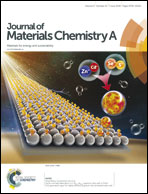Ultrahigh energy-storage potential under low electric field in bismuth sodium titanate-based perovskite ferroelectrics
Abstract
Relaxor ferroelectrics are receiving an increasing amount of attention because of their superior energy-storage density. Due to environmental concerns, lead-free alternatives are highly desirable, with bismuth sodium titanate highlighted for its energy-storage applications. Here, we realized an enhancement in energy-storage performance with a recoverable energy density (Wrec) of 2.42 J cm−3 (low electric field of E = 143 kV cm−1) in {Bi0.5[(Na0.8K0.2)0.90Li0.10]0.5}0.96Sr0.04(Ti0.975Ta0.025)O3 ceramics by a hot-pressed sintering (HPS) method, which is greatly superior to the reported perovskite ceramics under similar electric fields. In addition, excellent fatigue and thermal stabilities (variation of Wrec ≤ 0.047% after 105 cycles and Wrec > 2 J cm−3 over 25–175 °C) can be observed. The HPS method greatly increases the dielectric breakdown strength (DBS ∼ 143 kV cm−1) because of a denser structure consisting of large and small grains, which is superior to those (78–97 kV cm−1) of spark plasma sintering (SPS), conventional air sintering (CAS), and MnO aids sintering (AS) methods. In addition to the contribution of the enhanced breakdown strength, the ultrahigh energy-storage density is also due to the almost complete RE to FE transition resulting from strain, polarization, and current density versus electric field (S–E, P–E, j–E) loops. Interestingly, a giant strain of 0.65% can also be found by the HPS method. In particular, a conceptual model based on the nature of relaxor ferroelectrics is employed to understand the excellent energy-storage properties observed in this work. We believe that the findings in this work may provide future tips and guidance for this direction of study.



 Please wait while we load your content...
Please wait while we load your content...